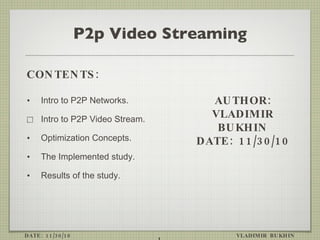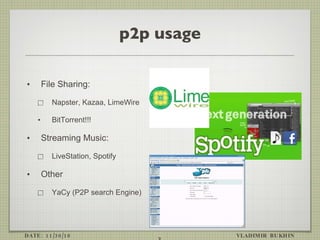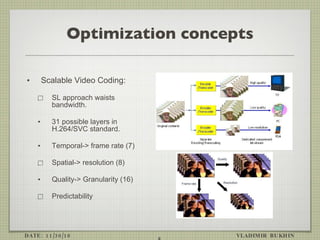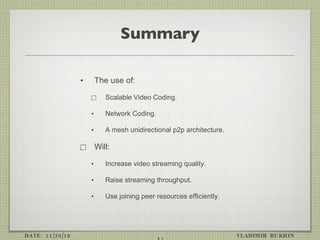Livestream Video P2P
- 1. P2p Video Streaming Intro to P2P Networks. Intro to P2P Video Stream. Optimization Concepts. The Implemented study. Results of the study. DATE: 11/30/10 VLADIMIR BUKHIN CONTENTS: AUTHOR: VLADIMIR BUKHIN DATE: 11/30/10
- 2. Defining p2p Distributed Architecture that partitions tasks between peers. Peers act as clients and servers. Consumers and Suppliers. DATE: 11/30/10 VLADIMIR BUKHIN
- 3. p2p usage File Sharing: Napster, Kazaa, LimeWire BitTorrent!!! Streaming Music: LiveStation, Spotify Other YaCy (P2P search Engine) DATE: 11/30/10 VLADIMIR BUKHIN
- 4. Intro to Live Stream Implemented systems: SopCast, TVAnts, PPLive. Challenges: Heterogeneity of Peers. High Churn Rate Solutions: Utilize peers efficiently. Support diverse receiver resources. Quickly adapt to network dynamics. DATE: 11/30/10 VLADIMIR BUKHIN
- 5. Optimization concepts Scalable Video Coding: SL approach waists bandwidth. 31 possible layers in H.264/SVC standard. Temporal-> frame rate (7) Spatial-> resolution (8) Quality-> Granularity (16) Predictability DATE: 11/30/10 VLADIMIR BUKHIN
- 6. Mesh VS Tree Differences Management cost. Churn rate handling Parent dependency. DATE: 11/30/10 VLADIMIR BUKHIN
- 7. Random Network Coding Send partial data. Many peers upload. Greater Throughput. DATE: 11/30/10 VLADIMIR BUKHIN
- 8. Sender NC process Sender Encoding: Data broken into blocks. Random blocks encoded. Coefficients attached and packets sent. DATE: 11/30/10 VLADIMIR BUKHIN BLOCKS OF DATA: b 1, b 2 , b 3 ,...,b n. VECTOR OF COEF: C=[0 1 0 1 0 0 1 0] LINEAR ENCODING:
- 9. Receiver decoding Receiver decoding: Downloads Linear combinations. Use Guassian Elimination if m>n. Solves for unknowns Progressively Negligible dependency rate. DATE: 11/30/10 VLADIMIR BUKHIN EXAMPLE MATRIX: [1 0 1 0 0 0 0 0][X 1 ] [0 1 1 0 0 0 0 0][X 2 ] [1 1 0 0 0 0 0 0][X 3 ] ... [0 0 0 1 1 1 0 0][X 8 ]
- 10. Peer process Full Peer Process: DATE: 11/30/10 VLADIMIR BUKHIN
- 11. The Implementation Three Video chosen with 850, 500, and 325 Kbps. 1000 peers join at random, 10% leave the system. Experiments with high churn rates and flash crowds. DATE: 11/30/10 VLADIMIR BUKHIN VARIATIONS TESTED: 1. SVC + NC 2. SVC 3. SL + NC 4. SL
- 12. Results DATE: 11/30/10 VLADIMIR BUKHIN Average Stream Rate Average Stream Quality
- 13. high churn rate DATE: 11/30/10 VLADIMIR BUKHIN High Churn Rate Flash Crowds
- 14. nc size results Optimal Block Size: 512 bytes. Optimal Segment Size= ((Video Bit Rate)/8)*(optimal segment time) = 100- 200kB DATE: 11/30/10 VLADIMIR BUKHIN
- 15. Summary The use of: Scalable Video Coding. Network Coding. A mesh unidirectional p2p architecture. Will: Increase video streaming quality. Raise streaming throughput. Use joining peer resources efficiently. DATE: 11/30/10 VLADIMIR BUKHIN
- 16. References Shabnam Mirshokraie and Mohamed Hefeeda. 2010. Live peer-to-peer streaming with scalable video coding and networking coding. In Proceedings of the first annual ACM SIGMM conference on Multimedia systems (MMSys '10). ACM, New York, NY, USA, 123-132. Chen Feng and Baochun Li. 2008. On large-scale peer-to-peer streaming systems with network coding. In Proceeding of the 16th ACM international conference on Multimedia (MM '08). ACM, New York, NY, USA, 269-278. Schwarz, H.; Marpe, D.; Wiegand, T.; , "Overview of the Scalable Video Coding Extension of the H.264/AVC Standard," Circuits and Systems for Video Technology, IEEE Transactions on , vol.17, no.9, pp.1103-1120, Sept. 2007 Wang, N.; Ansari, N.; , "Downloader-Initiated Random Linear Network Coding for Peer-to-Peer File Sharing," Systems Journal, IEEE , vol.PP, no.99, pp.1-1, 0 Kim, MinJi; Sundararajan, Jay Kumar; Medard, Muriel; , "Network Coding for Speedup in Switches," Information Theory, 2007. ISIT 2007. IEEE International Symposium on , vol., no., pp.1086-1090, 24-29 June 2007 Google Images. 11/26/10 http://en.wikipedia.org/wiki/Peer-to-peer , 11/26/10 DATE: 11/30/10 VLADIMIR BUKHIN








![Sender NC process Sender Encoding: Data broken into blocks. Random blocks encoded. Coefficients attached and packets sent. DATE: 11/30/10 VLADIMIR BUKHIN BLOCKS OF DATA: b 1, b 2 , b 3 ,...,b n. VECTOR OF COEF: C=[0 1 0 1 0 0 1 0] LINEAR ENCODING:](https://image.slidesharecdn.com/livestreampresk-101206110308-phpapp02/85/Livestream-Video-P2P-8-320.jpg)
![Receiver decoding Receiver decoding: Downloads Linear combinations. Use Guassian Elimination if m>n. Solves for unknowns Progressively Negligible dependency rate. DATE: 11/30/10 VLADIMIR BUKHIN EXAMPLE MATRIX: [1 0 1 0 0 0 0 0][X 1 ] [0 1 1 0 0 0 0 0][X 2 ] [1 1 0 0 0 0 0 0][X 3 ] ... [0 0 0 1 1 1 0 0][X 8 ]](https://image.slidesharecdn.com/livestreampresk-101206110308-phpapp02/85/Livestream-Video-P2P-9-320.jpg)






